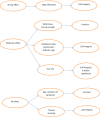A Systematic Summary of Systematic Reviews on the Topic of the Rotator Cuff
- PMID: 30320144
- PMCID: PMC6154263
- DOI: 10.1177/2325967118797891
A Systematic Summary of Systematic Reviews on the Topic of the Rotator Cuff
Abstract
Background: The number of systematic reviews and meta-analyses published on the rotator cuff (RC) has increased markedly.
Purpose: To quantify the number of systematic reviews and meta-analyses published on the RC and to provide a qualitative summary of the literature.
Study design: Systematic review; Level of evidence, 4.
Methods: A systematic search for all systematic reviews and meta-analyses pertaining to the RC published between January 2007 and September 2017 was performed with PubMed, MEDLINE, and the Cochrane Database of Systematic Reviews. Narrative reviews and non-English language articles were excluded.
Results: A total of 1078 articles were found, of which 196 met the inclusion criteria. Included articles were summarized and divided into 15 topics: anatomy and function, histology and genetics, diagnosis, epidemiology, athletes, nonoperative versus operative treatment, surgical repair methods, concomitant conditions and surgical procedures, RC tears after total shoulder arthroplasty, biological augmentation, postoperative rehabilitation, outcomes and complications, patient-reported outcome measures, cost-effectiveness of RC repair, and quality of randomized controlled trials.
Conclusion: A qualitative summary of the systematic reviews and meta-analyses published on the RC can provide surgeons with a single source of the most current literature.
Keywords: meta-analysis; repair; rotator cuff; systematic review.
Conflict of interest statement
One or more of the authors has declared the following potential conflict of interest or source of funding: This study was funded by the Ralph C. Wilson Jr Foundation. L.J.B. is a paid speaker/presenter for Arthrex, has received royalties from Zimmer Biomet, and has received hospitality payments from Prodigy Surgical Distribution. AOSSM checks author disclosures against the Open Payments Database (OPD). AOSSM has not conducted an independent investigation on the OPD and disclaims any liability or responsibility relating thereto.
Figures
Similar articles
-
A Systematic Summary of Systematic Reviews on the Topic of the Anterior Cruciate Ligament.Orthop J Sports Med. 2016 Mar 15;4(3):2325967116634074. doi: 10.1177/2325967116634074. eCollection 2016 Mar. Orthop J Sports Med. 2016. PMID: 27047983 Free PMC article.
-
An Up-to-Date Review of the Meniscus Literature: A Systematic Summary of Systematic Reviews and Meta-analyses.Orthop J Sports Med. 2020 Sep 9;8(9):2325967120950306. doi: 10.1177/2325967120950306. eCollection 2020 Sep. Orthop J Sports Med. 2020. PMID: 32953923 Free PMC article. Review.
-
Platelet-Rich Plasma Augmentation of Arthroscopic Rotator Cuff Repair Lowers Retear Rates and Improves Short-Term Postoperative Functional Outcome Scores: A Systematic Review of Meta-Analyses.Arthrosc Sports Med Rehabil. 2022 Feb 5;4(2):e823-e833. doi: 10.1016/j.asmr.2021.12.012. eCollection 2022 Apr. Arthrosc Sports Med Rehabil. 2022. PMID: 35494273 Free PMC article. Review.
-
Does an Increased Critical Shoulder Angle Affect Re-tear Rates and Clinical Outcomes Following Primary Rotator Cuff Repair? A Systematic Review.Arthroscopy. 2019 Oct;35(10):2938-2947.e1. doi: 10.1016/j.arthro.2019.03.063. Epub 2019 Sep 9. Arthroscopy. 2019. PMID: 31515108
-
Surgery for rotator cuff tears.Cochrane Database Syst Rev. 2019 Dec 9;12(12):CD013502. doi: 10.1002/14651858.CD013502. Cochrane Database Syst Rev. 2019. PMID: 31813166 Free PMC article.
Cited by
-
Acupuncture and manual therapy for rotator cuff tears: A protocol for systematic review and meta analysis.Medicine (Baltimore). 2020 May 22;99(21):e20377. doi: 10.1097/MD.0000000000020377. Medicine (Baltimore). 2020. PMID: 32481335 Free PMC article.
-
Therapeutic Exercise Prescription for Overhead Athletes with Shoulder Impingement Syndrome: A Systematic Review and CERT Analysis.J Clin Med. 2025 Feb 28;14(5):1657. doi: 10.3390/jcm14051657. J Clin Med. 2025. PMID: 40095639 Free PMC article. Review.
-
Diagnostic Performance of Articular Ultrasound Versus Magnetic Resonance Imaging in the Approach to Rotator Cuff Lesions at a Referral Hospital.Cureus. 2025 Mar 25;17(3):e81149. doi: 10.7759/cureus.81149. eCollection 2025 Mar. Cureus. 2025. PMID: 40276414 Free PMC article.
-
A comparison of simple and complex single-row versus transosseous-equivalent double-row repair techniques for full-thickness rotator cuff tears: a systematic review and meta-analysis.JSES Int. 2021 Oct 26;6(1):70-78. doi: 10.1016/j.jseint.2021.09.007. eCollection 2022 Jan. JSES Int. 2021. PMID: 35141679 Free PMC article. Review.
-
Differences in the effectiveness of leukocyte-rich platelet-rich plasma compared with leukocyte-poor platelet-rich plasma in the treatment of rotator cuff surgery: an umbrella review of meta-analyses.J Orthop Traumatol. 2024 Oct 24;25(1):50. doi: 10.1186/s10195-024-00791-1. J Orthop Traumatol. 2024. PMID: 39446263 Free PMC article. Review.
References
-
- Ahmad Z, Wardale J, Brooks R, Henson F, Noorani A, Rushton N. Exploring the application of stem cells in tendon repair and regeneration. Arthroscopy. 2012;28(7):1018–1029. - PubMed
-
- Andia I, Maffulli N. Muscle and tendon injuries: the role of biological interventions to promote and assist healing and recovery. Arthroscopy. 2015;31(5):999–1015. - PubMed
Publication types
LinkOut - more resources
Full Text Sources
Miscellaneous



